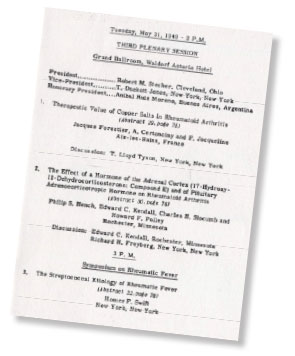
I greatly enjoyed Charley Plotz’s reminiscences about the beginnings of rheumatology as a specialty and of his own role in its evolution (“Speak Out Rheum: The First Days of Rheumatology,” July 2013). However, there was a significant omission in his list of early investigators in the field: Robert M. Stecher (1896–1972). Dr. Stecher was not based at a major academic center, as were the individuals Dr. Plotz mentioned; rather, he established a small arthritis clinic at The Cleveland City Hospital in 1935. (This institution later achieved academic prominence as Cleveland Metropolitan General Hospital, currently MetroHealth Medical Center.) There, he quietly and compassionately cared for patients with rheumatic disease. He was deeply involved in the formation of the American Rheumatism Association and its predecessor; his history of this organization was the first paper published in Arthritis & Rheumatism.1 He was presiding as president of the American Rheumatism Association when Philip Hench presented his blockbuster findings on the effects of corticosteroids on rheumatoid arthritis on May 31, 1949, as so nicely described by Dr. Plotz (see Figure 1). He also served as president of the International League Against Rheumatism (1953–1957) and became close friends with most of the pioneers in rheumatology around the world.2 A warm and generous man, he personally saw to it that his colleagues behind the iron curtain had access to the rheumatologic literature.
A half century ahead of his time, he pursued the role of genetics in rheumatic disease in a stream of publications in the ’40s and ’50s. Lacking the powerful tools available for genetic studies today, he and his collaborators performed careful family studies and described the role of heredity in ankylosing spondylitis, gout, rheumatoid arthritis, and Heberden’s nodes.3-6 When he delivered The Heberden Oration in London in 1954, his topic was Heberden’s Nodes, a topic never addressed in that venue before or since, to my knowledge.7 In this presentation, he described, among other things, the incidence of this condition, its familial occurrence, its association with menopause, its radiologic features, and its failure to occur in the presence of peripheral nerve damage. Of greatest interest, he also presented an informative pedigree analysis of three generations of a very afflicted large family, described the mode of its inheritance, carried out gene frequency analysis, and, employing the tools of the day, explored other genetic issues. This publication is a model of careful, patient-based clinical research.

